Purpose, Procedure, and Preparation
Overview
In this informative guide, we explore the world of CT scans. Shedding light on their advantages, dosage guidelines, and how useful they are to you and your provider in helping you make informed health decisions. Whether preparing for a CT scan or simply curious about the technology, this guide will provide valuable insight and knowledge.
Introduction
When it comes to medical imaging, it is essential to understand the differences between CT (Computed Tomography) scans and X-rays. These machines vary in image details, how they are produced, and the areas of the body they examine. X-rays use low doses of radiation, making them ideal for assessing bones and specific medical conditions. Computed Tomography (CT) scans use X-rays but offer a more comprehensive view of the inside of the body, including bones, chest, abdomen, and pelvis. Choosing the right imaging exam is pivotal to ensure the most accurate diagnosis and effective treatment.
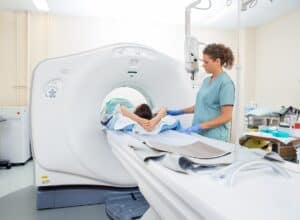
Understanding CT Scans
CT scans are non-invasive imaging procedures that use radiation to detect bone and tissue abnormalities. An X-ray tube will rotate around you, capturing multiple images from various angles. A computer then compiles these images, offering a comprehensive view of the inside of your body, including bones, chest, abdomen, and pelvis, which helps our radiologists provide an accurate diagnosis.
Advantages vs Limitations of CT scans
Advantages of CT scans:
- Rapid imaging, suitable for emergency cases.
- Effective for visualizing bone fractures and chest and lung conditions.
- Often used in guiding surgical procedures.
Limitations of CT scans:
- Involves exposure to ionizing radiation.
- May not provide the same level of soft tissue detail as MRI.
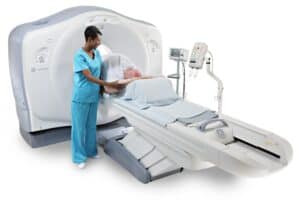
Understanding X-Rays
X-rays play a pivotal role in diagnosing various conditions and injuries. These imaging procedures involve using electromagnetic radiation in the form of X-rays to capture images of the body’s internal structures. Unlike CT scans, X-rays do not rely on rotating X-ray tubes but instead emit a focused beam of radiation through the body, which is captured by a detector on the opposite side. This technique provides real-time images, making X-rays valuable for different medical scenarios.
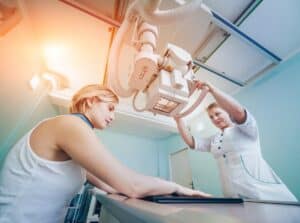
Advantages vs Limitations of X-Rays
Advantages of X-ray exams:
- Speedy imaging process, making it ideal for quick assessments.
- Effective for visualizing bone fractures and joint injuries.
- Commonly used for guiding certain specific procedures.
Limitations of X-Ray exams:
- Involves exposure to ionizing radiation at relatively low doses.
- May not offer the same level of detail as CT scans.
Comparison of CT Scans and X-Rays
Understanding the distinctions between X-ray and CT scans is essential for making informed decisions about your healthcare. Let’s dive into a side-by-side comparison to help you learn more:
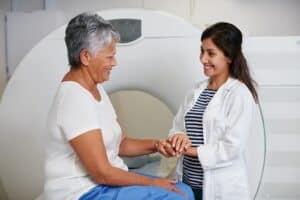
Imaging Technology and How They Differ
- X-ray: Uses a focused beam of X-rays to create real-time images by passing through the body.
- CT: Relies on X-rays and a rotating X-ray tube to produce images, making it ideal for visualizing bones and internal structures.
The Kind of Images Each Exam Produces and Their Clarity/Detail
- X-ray: Offers immediate images, best for assessing bone fractures and joint injuries.
- CT: Provides clear images of bones, chest, abdomen, and pelvis.
The Types of Medical Conditions Each Exam Is Better Suited For
- X-ray: Typically used for quick assessments of bone injuries and joint issues and for monitoring specific medical procedures.
- CT: Well-suited for detecting heart disease, certain types of cancer, blood clots, spinal cord injuries, bone fractures, lung conditions, and many more, including urgent medical cases where quick imaging is critical.
Duration and Your Experience During the Scan
- X-ray: Usually involves short imaging sessions, often requiring minimal patient stillness. Scans last just a few seconds.
- CT: Known for its speed, CT scans often have quick exams that last just a few seconds, requiring less stillness as you lay on the table, resulting in a more comfortable experience.
Safety Considerations, Including Exposure to Radiation
- X-ray: Involves radiation exposure, but doses are typically low.
- CT: Also involves radiation exposure; however, our scanners use new ASIR dose-reduction technology that offers the safest and lowest dose radiation.
CT Scan Preparation
Preparing for a CT scan is straightforward, making it a convenient diagnostic procedure for patients. Here’s a list of CT Scan preparation essentials for what you can expect and how to prepare:
- Fasting: Your provider may recommend fasting before the scan, mainly for abdominal or pelvic scans.
- Clothing: You may be asked to change into a hospital gown.
- Jewelry: Leave metal items at home or remove them before the scan.
- Contrast: You’ll be informed about contrast material use if needed, and you’ll need to inform the doctor if you have any kidney problems.
- Allergies: You will need to notify the doctor or technologist of allergies to contrast materials, medications, or iodine.
- Medications: Continue regular medications unless advised otherwise by your doctor.
- Pregnancy: Inform the doctor if you are or suspect you are pregnant.
- Scan Duration: The scans are typically a few minutes but vary by the examined area.
- During the Scan: You will lie still on the table, which moves through the scanner. The technologist will communicate with you during the entire scan from the control room.
- After the Scan: Typically, you will resume normal activities immediately. You will need to drink plenty of fluids if you had contrast material.
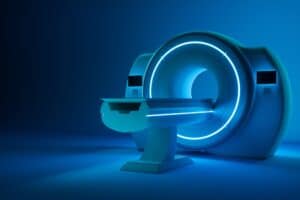
How Contrast Works for CT Scans and Any Potential Side Effects
Contrast agents are valuable tools in enhancing the clarity of CT scan images. They make certain body structures and abnormalities more visible, helping radiologists diagnose more accurately. Contrast agents are beneficial and generally safe. Any potential side effects are typically mild and short-lived.
How Contrast Works
- During a CT scan, a contrast agent is administered either orally and/or with an IV
- The contrast agent interacts with X-rays, making blood vessels, organs, or other tissues stand out in the images.
- Helps radiologists differentiate between normal and abnormal structures.
- Provides a more transparent view for a more precise diagnosis.
Contrast Side Affects
- Warm or metallic taste in the mouth.
- A brief sensation of heat or flushing.
- Mild nausea.
- These effects typically subside quickly and are not a cause for concern.
- It’s essential to inform your doctor if you’ve had any prior reactions to contrast.
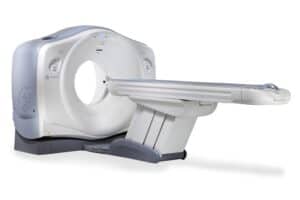
The Safety of CT scans: Radiation Doses and Minimizing Exposure
CT scans are powerful diagnostic tools, allowing healthcare providers to obtain detailed images of internal structures, aiding in diagnosing and treating various medical conditions. However, it’s natural to have concerns about the safety of CT scans, particularly regarding radiation exposure.
Low Radiation Doses
- Provide high-quality images with the lowest possible radiation dose.
- Modern CT technology has significantly reduced radiation levels.
- Jefferson Radiology is accredited by both Image Wisely and Image Gently, reflecting our commitment to providing the highest standards of safety and quality in CT scanning
- This recognition underscores our dedication to using the lowest radiation doses possible during imaging, ensuring a safer, more comfortable experience.
How Your CT Scan Results Are Interpreted
Our experienced radiologists play a pivotal role in the analysis of your CT scan. These sub-specialized physicians examine each image meticulously. They focus on structures, organs, and abnormalities within the scanned area while looking for irregularities or signs of disease. The radiologist’s findings are shared with your provider, and they collaborate to create a seamless plan, ensuring your well-being.
Conclusion
In conclusion, gaining insight into the world of CT scans provides you with the knowledge needed to make well-informed choices regarding your health. At Jefferson Radiology, we are committed to providing subspecialized radiology services paired with the highest quality care. From preparation to the significance of contrast and the secure and efficient scanning process, CT scans serve as a valuable tool in your path toward improved health and well-being.
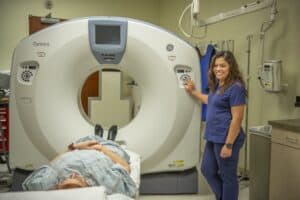
Resources
- The National Institute of Biomedical Imaging and Bioengineering (NIBIB) provides information on medical imaging technologies, including X-Rays CT scans and Low Dose Technology for CT Scans.
- Radiological Society of North America (RSNA): RSNA offers educational materials and resources related to medical imaging, including articles and guidelines.
- American College of Radiology (ACR) provides guidelines, patient resources, and up-to-date information about radiological procedures, including CT scans.
- Mayo Clinic’s website offers extensive information about various medical conditions, diagnostic procedures, imaging techniques, and clinical trials for CT scans.








